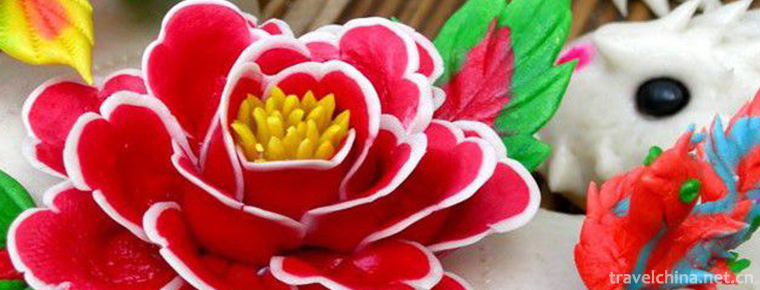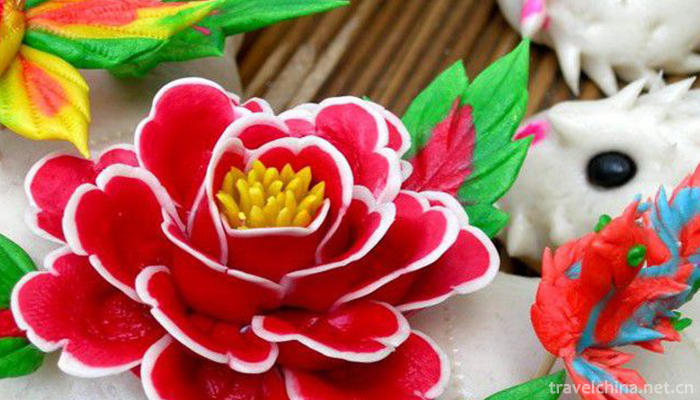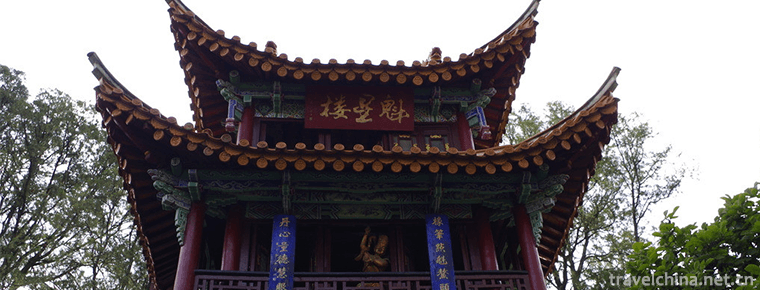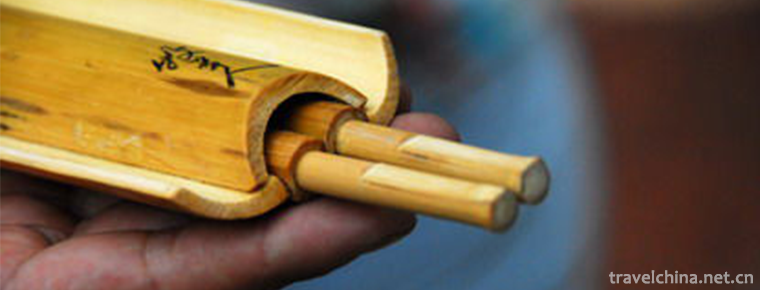2018-12-22

- By ChinaWiki.net
- Chinese Edition
- 2019-06-05
Dough Flowers
Flower, commonly known as "flower bun", belongs to the art of facial sculpture. There are weddings, funerals, birthday gifts, Festival buns. Flowers are made of ordinary flour and special flour as skin. They are made by pinching, cutting, trimming and decorating with needles, combs, knives and scissors.
Legend has it that it is the product of the evolution of ancient totem stone rituals, but also the crystallization of the wisdom of Chinese working women. Northern folk is prevalent, especially in Heyang and Huaxian.
In November 2014, floral flowers were listed in the National Intangible Cultural Heritage Representative project directory expansion project directory.
Historical origin
Facial flowers originated from traditional folk sacrificial activities. According to the book "The Origin of Things" written by Gaocheng in the Song Dynasty, when Zhuge Wuhou marched on Meng Huo, some people said that the barbarians had many evil arts, they had to sacrifice gods with human heads, and they could be assisted by Yinbing. Zhuge Wuhou made a human head with bread of cattle, sheep and pork to sacrifice the gods. From then on, there was the saying of steamed bread. Therefore, Chinese folk flour originated in the Han Dynasty, and it appeared as a gift.
In Tang Dynasty, floral flowers were used as sacrificial offerings. By the Song Dynasty, the floral art was more prosperous. In Tokyo Menghualu, Senior Meng recorded the folk life at that time, from which we can see that all kinds of floral flowers in the Northern Song Dynasty were inseparable from the seasons of life. In the Ming Dynasty, Chinese folk flour making was quite popular at that time. People used rice flour wrapped in stuffing to form dough, and then used fruit moulds of different shapes to make various flour. This method is still in use today.
In the Qing Dynasty, the method of making noodles with printing moulds had many objects to be tested. Such as "Ruyi Cake" for New Year's Day, "Dragon and Phoenix Happy Cake" for weddings, "Five Poisonous Cakes" for Dragon Boat Festival, and "Dark Eight Immortals", "Eight Treasures" and "Jade Rabbit Massage" moon cakes for Mid-Autumn Festival. At the end of the Qing Dynasty, there were also artists specializing in making noodles in Beijing. This kind of noodles are more sold as toys for children to play with and handicraft for people to watch. Among them, Tang Zibo, Lang Shao'an and Cao Yice are the most famous ones in Beijing. In modern times, all kinds of floral art are more colorful and varied.
Related Legends
Shenqiu County's "Gujia Huabing" is very famous in China. Legend has it that a man named Gu Erbiezi was the first to get his name. Gu Jiahua bun makes forty small buns in the shape of waist gourds with a kilogram of noodles. Push a pattern on them with a wooden comb, and use peach kernels on the tips of buns. A vivid little longevity peach appears in front of you. Gu Jiahua steamed bun has the greatest characteristicsof dryness, durability, long-term storage without mildew and cracking, when eaten, once distilled, restored as before. Legend has it that Yuan Shikai, a burglar from Xiangcheng, who stole the country at the end of the Qing Dynasty, paid tribute to Empress Dowager Cixi with Shenqiu's flower steamed bun, which was highly appreciated by Empress Dowager Cixi. Shenqiu's fame of "Gujia Huawen" was boosted. It is said that since then, "Gujia Huawen" was also called "Gongwen".
"Gu Jia Huabing" has a wide range of themes and patterns, such as mother and child monkeys, ponies, dogs, lambs, flour fish, varied and varied manner. That childish look, naive motions, people can not help but love. Artists are highly skilled. The shape of small animals is exaggerated and generalized.
The color design of Shenqiu pasta toys is also influenced by Zhuxian Town woodcut New Year pictures. With pink yellow, pink green and scarlet as the keynote, and then depicted with black, the artist pays great attention to the contrast effect of color and the portrayal of various characters and animals, which is wonderful between similarity and dissimilarity.
From the above situation, we can see that the dough sculpture technology, in Henan and even in the northern provinces of China, is closely related to traditional folklore and has a broad mass base. Every time before the Spring Festival, the traditional festival of our people, rural households have to do some pasta artworks, some of which are made into various fruits and flours, and placed on the square table of the hall as ornamental objects. Some make many steamed buns, longevity peaches and flower cakes as gifts for relatives and friends. Mothers take this opportunity to make many dramatic characters and interesting animals for children to eat and play with.
Related customs
Lingbao's "nest flower", commonly known as "face flower", also known as "cake flower". Cake flower is divided into "Gaohua" and "Pinghua" two varieties, "Gaohua" production method is: hand-shaped steamed, and then painted, and then inserted in the round cake with bamboo sticks, gorgeous, beautiful, lifelike, colorful, is used when men and women order relatives, women give gifts to the male family, indicating the girl's ingenuity; "Pinghua" does not dye, and pastry coincide. As a whole, it is full and simple and generous, indicating that the young man is strong and capable. This is a gift from the man to the girl's family. In short, it is full of life interest.
Development history
Flower art works have entered the market during the traditional festivals, and artists with better skills have made a large number of them, which have been sold in markets, counties and urban areas. They are very popular among city people. In this way, "flour" is not only the food of festivals, but also has appeared in the commodity market as "Chinese folk art", which has produced economic benefits.
According to a preliminary survey, at the January meeting of Xunxian County, the February meeting of Huaiyang and the March meeting of Dengfeng, there were artists selling "flour". In the past, most of the artists in Huaidian Township of Shenqiu pinched and sold "flour" before and after the Spring Festival, which became a long-term production and sale. People have gradually become accustomed to the birthday of children. Old people have to buy some flour to congratulate on their birthday. It is worth mentioning that as far as Beijing and as close as Shandong, Hebei, Anhui and other provinces, some traditional folk art collectors, art workers and experts and scholars at home and abroad have joined the purchase list, their main purpose is to collect and academic research.
Shandong flower
Shandong is a pasta-based area. Flour products are indispensable in offering sacrifices to the ancestors of heaven and earth, celebrating marriage and birth, and the etiquette and customs of the age. Besides the large-scale jujube cake, jujube steamed bread and the embossed pot helmet cake, the "Yuer Guozi" and "Qiaoguo" of the fruit model products of "bao zi" popular among the Chinese people along the coast of Jiaodong are also the derivatives of hand-made flour. All kinds of fruit moulds, big and small, with very lovely patterns, are inseparable from traditional patterns, such as fish, chicken, eight treasures, lions, cicadas, melons and fruits, lotus seed peng, pomegranate peaches, bats and so on.
During marriage, funeral, birthday and auspicious festival of a year, people with financial ability are branded with fruit mold products traditionally called "fish and fruit" as gifts to relatives and friends. Every July 7th and children's birthdays, bake small fruit models at home, tie them up with red thread, hang them like necklaces around children's necks, representing blessings and bonding interpersonal relationships. The fruit pattern carved by craftsmen is very similar to the pattern shape of Chinese folk blue print cloth, which is particularly coordinated in Chinese folk art.
Huanghua flower
Huanghua Flower has a history of 200 years. In ancient Huanghua, the land was barren, the wheat yield was very low, and people lived in poverty. Every New Year's Day, when people have nothing to give, they grind a small amount of wheat into flour, steam into peaches, carp and other flour flowers to relatives and friends, for good luck. Over time, a kind of custom has been formed, and flour has a better taste than steamed bread. It has been gradually accepted by people and formed a unique dietary culture. Flower making skills were selected as provincial intangible cultural heritage, which made steamed flour have a deeper meaning.
Cultural inheritance
Among the numerous traditional folk floral art in China, Lingbao in Western Henan and Gujia floral in Shenqiu in eastern Henan are the most famous. Lingbao Flower, according to textual research proves that the Qing Dynasty has. In the early years, facial flowers came into being with local folk activities, called "nest flowers", which are the tribute of the local people to "worship gods" on the 15th day of the first lunar month. According to the old people, everyone who attends the temple fair should come to the temple to worship God, and those who are especially devout to God will reach an agreement to take turns in presiding over the annual ceremonies. Whoever is in charge of financing, and after entering December, the local famous "Qiaoqiao" people (skillful daughter-in-law who has the skills of making facial flowers) are invited to knead the "nest" (facial flowers) in their homes. These artists are both skillful and devout. They bathe and eat, and carefully pinch out non-duplicate facial flowers, such as dragons, wind, lions, tigers, flowers, birds, fish, insects, and the "Twelve Zodiac" and so on. Their shapes are vivid and lifelike. When the floral flowers are ready, they are inserted on three 2-meter-high straw towers tied with wheat straw.
On the day of the temple fair, firecrackers burst out and cigarettes filled with smoke. The host placed the "nest flowers" and "straw pagodas" made by the "Qiaoqiao people" in the temple yard for God to enjoy. He asked God to bless the villagers in the four seasons of peace, smooth weather and abundant grain. With the passage of time and the continuous progress of society, today's rural areas have moved towards modernization. Farmers have basically achieved the goal of drought, flood and bumper harvest by scientific farming. The superstitious idea of relying on heaven for food and praying for God's blessing has been gradually reduced or lost. Flower, an ancient pasta art, has changed from offering sacrifices to gifts to relatives and friends in New Folk activities. For example, when young men and women are engaged, children should make flour flowers to give gifts to relatives and friends so as to achieve the purpose of auspiciousness and congratulations.
Inheritance significance
Historical origin
Facial flowers originated from traditional folk sacrificial activities. According to the book "The Origin of Things" written by Gaocheng in the Song Dynasty, when Zhuge Wuhou marched on Meng Huo, some people said that the barbarians had many evil arts, they had to sacrifice gods with human heads, and they could be assisted by Yinbing. Zhuge Wuhou made a human head with bread of cattle, sheep and pork to sacrifice the gods. From then on, there was the saying of steamed bread. Therefore, Chinese folk flour originated in the Han Dynasty, and it appeared as a gift.
In Tang Dynasty, floral flowers were used as sacrificial offerings. By the Song Dynasty, the floral art was more prosperous. In Tokyo Menghualu, Senior Meng recorded the folk life at that time, from which we can see that all kinds of floral flowers in the Northern Song Dynasty were inseparable from the seasons of life. In the Ming Dynasty, Chinese folk flour making was quite popular at that time. People used rice flour wrapped in stuffing to form dough, and then used fruit moulds of different shapes to make various flour. This method is still in use today.
In the Qing Dynasty, the method of making noodles with printing moulds had many objects to be tested. Such as "Ruyi Cake" for New Year's Day, "Dragon and Phoenix Happy Cake" for weddings, "Five Poisonous Cakes" for Dragon Boat Festival, and "Dark Eight Immortals", "Eight Treasures" and "Jade Rabbit Massage" moon cakes for Mid-Autumn Festival. At the end of the Qing Dynasty, there were also artists specializing in making noodles in Beijing. This kind of noodles are more sold as toys for children to play with and handicraft for people to watch. Among them, Tang Zibo, Lang Shao'an and Cao Yice are the most famous ones in Beijing. In modern times, all kinds of floral art are more colorful and varied.
Related Legends
Shenqiu County's "Gujia Huabing" is very famous in China. Legend has it that a man named Gu Erbiezi was the first to get his name. Gu Jiahua bun makes forty small buns in the shape of waist gourds with a kilogram of noodles. Push a pattern on them with a wooden comb, and use peach kernels on the tips of buns. A vivid little longevity peach appears in front of you. Gu Jiahua steamed bun has the greatest characteristicsof dryness, durability, long-term storage without mildew and cracking, when eaten, once distilled, restored as before. Legend has it that Yuan Shikai, a burglar from Xiangcheng, who stole the country at the end of the Qing Dynasty, paid tribute to Empress Dowager Cixi with Shenqiu's flower steamed bun, which was highly appreciated by Empress Dowager Cixi. Shenqiu's fame of "Gujia Huawen" was boosted. It is said that since then, "Gujia Huawen" was also called "Gongwen".
"Gu Jia Huabing" has a wide range of themes and patterns, such as mother and child monkeys, ponies, dogs, lambs, flour fish, varied and varied manner. That childish look, naive motions, people can not help but love. Artists are highly skilled. The shape of small animals is exaggerated and generalized.
The color design of Shenqiu pasta toys is also influenced by Zhuxian Town woodcut New Year pictures. With pink yellow, pink green and scarlet as the keynote, and then depicted with black, the artist pays great attention to the contrast effect of color and the portrayal of various characters and animals, which is wonderful between similarity and dissimilarity.
From the above situation, we can see that the dough sculpture technology, in Henan and even in the northern provinces of China, is closely related to traditional folklore and has a broad mass base. Every time before the Spring Festival, the traditional festival of our people, rural households have to do some pasta artworks, some of which are made into various fruits and flours, and placed on the square table of the hall as ornamental objects. Some make many steamed buns, longevity peaches and flower cakes as gifts for relatives and friends. Mothers take this opportunity to make many dramatic characters and interesting animals for children to eat and play with.
Related customs
Lingbao's "nest flower", commonly known as "face flower", also known as "cake flower". Cake flower is divided into "Gaohua" and "Pinghua" two varieties, "Gaohua" production method is: hand-shaped steamed, and then painted, and then inserted in the round cake with bamboo sticks, gorgeous, beautiful, lifelike, colorful, is used when men and women order relatives, women give gifts to the male family, indicating the girl's ingenuity; "Pinghua" does not dye, and pastry coincide. As a whole, it is full and simple and generous, indicating that the young man is strong and capable. This is a gift from the man to the girl's family. In short, it is full of life interest.
Development history
Flower art works have entered the market during the traditional festivals, and artists with better skills have made a large number of them, which have been sold in markets, counties and urban areas. They are very popular among city people. In this way, "flour" is not only the food of festivals, but also has appeared in the commodity market as "Chinese folk art", which has produced economic benefits.
According to a preliminary survey, at the January meeting of Xunxian County, the February meeting of Huaiyang and the March meeting of Dengfeng, there were artists selling "flour". In the past, most of the artists in Huaidian Township of Shenqiu pinched and sold "flour" before and after the Spring Festival, which became a long-term production and sale. People have gradually become accustomed to the birthday of children. Old people have to buy some flour to congratulate on their birthday. It is worth mentioning that as far as Beijing and as close as Shandong, Hebei, Anhui and other provinces, some traditional folk art collectors, art workers and experts and scholars at home and abroad have joined the purchase list, their main purpose is to collect and academic research.
Shandong flower
Shandong is a pasta-based area. Flour products are indispensable in offering sacrifices to the ancestors of heaven and earth, celebrating marriage and birth, and the etiquette and customs of the age. Besides the large-scale jujube cake, jujube steamed bread and the embossed pot helmet cake, the "Yuer Guozi" and "Qiaoguo" of the fruit model products of "bao zi" popular among the Chinese people along the coast of Jiaodong are also the derivatives of hand-made flour. All kinds of fruit moulds, big and small, with very lovely patterns, are inseparable from traditional patterns, such as fish, chicken, eight treasures, lions, cicadas, melons and fruits, lotus seed peng, pomegranate peaches, bats and so on.
During marriage, funeral, birthday and auspicious festival of a year, people with financial ability are branded with fruit mold products traditionally called "fish and fruit" as gifts to relatives and friends. Every July 7th and children's birthdays, bake small fruit models at home, tie them up with red thread, hang them like necklaces around children's necks, representing blessings and bonding interpersonal relationships. The fruit pattern carved by craftsmen is very similar to the pattern shape of Chinese folk blue print cloth, which is particularly coordinated in Chinese folk art.
Huanghua flower
Huanghua Flower has a history of 200 years. In ancient Huanghua, the land was barren, the wheat yield was very low, and people lived in poverty. Every New Year's Day, when people have nothing to give, they grind a small amount of wheat into flour, steam into peaches, carp and other flour flowers to relatives and friends, for good luck. Over time, a kind of custom has been formed, and flour has a better taste than steamed bread. It has been gradually accepted by people and formed a unique dietary culture. Flower making skills were selected as provincial intangible cultural heritage, which made steamed flour have a deeper meaning.
Cultural inheritance
Among the numerous traditional folk floral art in China, Lingbao in Western Henan and Gujia floral in Shenqiu in eastern Henan are the most famous. Lingbao Flower, according to textual research proves that the Qing Dynasty has. In the early years, facial flowers came into being with local folk activities, called "nest flowers", which are the tribute of the local people to "worship gods" on the 15th day of the first lunar month. According to the old people, everyone who attends the temple fair should come to the temple to worship God, and those who are especially devout to God will reach an agreement to take turns in presiding over the annual ceremonies. Whoever is in charge of financing, and after entering December, the local famous "Qiaoqiao" people (skillful daughter-in-law who has the skills of making facial flowers) are invited to knead the "nest" (facial flowers) in their homes. These artists are both skillful and devout. They bathe and eat, and carefully pinch out non-duplicate facial flowers, such as dragons, wind, lions, tigers, flowers, birds, fish, insects, and the "Twelve Zodiac" and so on. Their shapes are vivid and lifelike. When the floral flowers are ready, they are inserted on three 2-meter-high straw towers tied with wheat straw.
On the day of the temple fair, firecrackers burst out and cigarettes filled with smoke. The host placed the "nest flowers" and "straw pagodas" made by the "Qiaoqiao people" in the temple yard for God to enjoy. He asked God to bless the villagers in the four seasons of peace, smooth weather and abundant grain. With the passage of time and the continuous progress of society, today's rural areas have moved towards modernization. Farmers have basically achieved the goal of drought, flood and bumper harvest by scientific farming. The superstitious idea of relying on heaven for food and praying for God's blessing has been gradually reduced or lost. Flower, an ancient pasta art, has changed from offering sacrifices to gifts to relatives and friends in New Folk activities. For example, when young men and women are engaged, children should make flour flowers to give gifts to relatives and friends so as to achieve the purpose of auspiciousness and congratulations.
Inheritance significance
Face-flower art is not only the typical representative of the tiger culture of Qin Dong, but also the treasure of Chinese folk culture. It is praised as the living fossil of the ancient tiger culture. It not only accumulates the historical evolution of Chinese folk culture, the changes of customs, the ups and downs of the tide of grace and the rich content of religious substitution, but also is the crystallization of modern wisdom of the people of Qin Dong. It can be said without exaggeration that face-flower art is the culture of Qin Dong and the integration of the Chinese people. The product of the combination of sports culture is an indispensable and important subject in the study of local culture. From its origin and development, we can not only dig out the formation track of tiger culture, but also perspective the formation and operation rules of gewenhua, Zhou culture and Wu culture from one side, reveal the relationship between court culture and Chinese folk culture, and glimpse the Xia-Qin culture and Zhou culture, oh culture, Xia culture and Chuwen culture. The integration and assimilation of Qilu and Qilu cultures have important cultural and historical significance. At the same time, as a comprehensive artistic materialization of the primitive cultural psychology, ancient cultural psychology and Longdai cultural psychology of the people in the eastern Qin Dynasty, facial flower art is also of great significance to the study of the cultural and spiritual structure of the western region and the further development of the western region. Based on this, this paper intends to use Du of Huazhou facial flower art. This paper makes a brief analysis of the functions of the association in order to arouse colleagues'attention to this cultural phenomenon.
Face-flower art is not only the typical representative of the tiger culture of Qin Dong, but also the treasure of Chinese folk culture. It is praised as the living fossil of the ancient tiger culture. It not only accumulates the historical evolution of Chinese folk culture, the changes of customs, the ups and downs of the tide of grace and the rich content of religious substitution, but also is the crystallization of modern wisdom of the people of Qin Dong. It can be said without exaggeration that face-flower art is the culture of Qin Dong and the integration of the Chinese people. The product of the combination of sports culture is an indispensable and important subject in the study of local culture. From its origin and development, we can not only dig out the formation track of tiger culture, but also perspective the formation and operation rules of gewenhua, Zhou culture and Wu culture from one side, reveal the relationship between court culture and Chinese folk culture, and glimpse the Xia-Qin culture and Zhou culture, oh culture, Xia culture and Chuwen culture. The integration and assimilation of Qilu and Qilu cultures have important cultural and historical significance. At the same time, as a comprehensive artistic materialization of the primitive cultural psychology, ancient cultural psychology and Longdai cultural psychology of the people in the eastern Qin Dynasty, facial flower art is also of great significance to the study of the cultural and spiritual structure of the western region and the further development of the western region. Based on this, this paper intends to use Du of Huazhou facial flower art. This paper makes a brief analysis of the functions of the association in order to arouse colleagues'attention to this cultural phenomenon.

Ask a Question
Your email address will not be published.



0 Questions